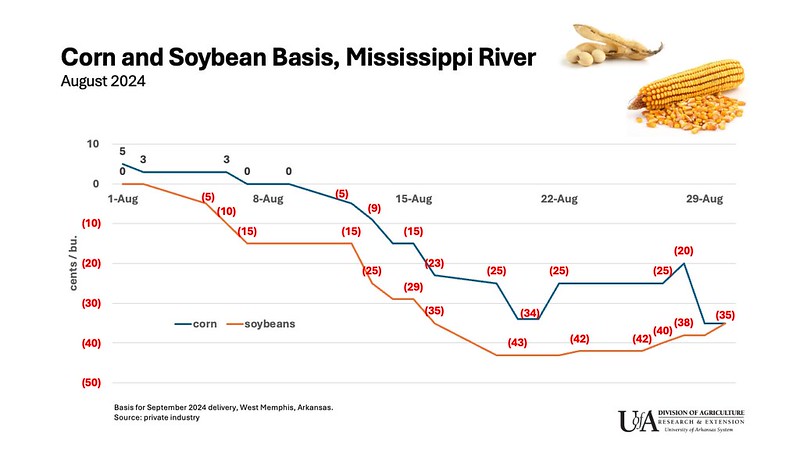Mississippi River continues to trend lower; draft restrictions in place for shipping
Sept. 5, 2024
By Mary Hightower
U of Arkansas System Division of Agriculture
Fast facts:
- Mississippi River at Memphis forecast to continue falling
- Draft restrictions mean less cargo can be carried on barges
(528 words)
(With chart of basis; map of Ohio River basin drought, file photos of barges)
JONESBORO, Ark. — Barges plying the shrinking lower Mississippi River have to reduce
their draft, meaning operators will have to cut the amount of cargo their boats carry
to meet the latest restrictions.
“The gauge at Memphis dropped to the low water threshold of minus 5 feet on Aug. 30,” said Scott Stiles, extension economics program associate for the University of Arkansas System Division of Agriculture. “The last two years, the U.S. Coast Guard initiated a 9-foot draft requirement when river levels fall below the low water threshold.
A normal draft, the distance between the waterline and the deepest point of the barge, when river conditions are good is about 12 feet at 1,500 tons, Stiles said.
“A barge loaded to a 9-foot draft will carry about 900 tons,” he said. “Each foot of reduced draft cuts a barge's cargo by 200 tons. This costs shippers money as they are paying the same amount of freight to ship less.
“Another way to look at it, if barge drafts are reduced from 12 feet to 9 feet, each barge would be hauling 20,000 fewer bushels of soybeans,” Stiles said.
“Grain terminals will need more barges or an alternative means of hauling such as truck or rail, but this added cost will pressure the basis,” he said. “We saw corn and soybean basis turn weaker in August as harvest began and transportation issues started to build on the Mississippi River.”
On Aug. 29, the river level was at minus 4.02 feet. On Sept. 1, the gauge dropped to minus 6 feet. The river rebounded slightly on Tuesday but declined below minus 6 feet by Wednesday afternoon.
“The Memphis gauge is lower now than it was at this time last year when the river eventually dropped to record lows,” Stiles said. “In October 2023, the Mississippi River reached a level of minus 11.91 feet on the Memphis gauge, which is the lowest since records began.”
Despite heavy rainfall in some parts of the upper Mississippi basin, the U.S. Drought Center said that “portions of the Ohio River Basin received only 25-75 percent of normal precipitation since June 11.” The Ohio River is a major feeder for the lower Mississippi River.
Third straight year
At an Aug. 19 meeting of the Mississippi River Commission, Marty Hettel of American Commercial Barge Line, said “It looks like we will once again see some drastic, extreme low-water conditions on the Lower Mississippi River for the third year in a row.”
The industry has resumed at least twice-weekly calls with the Corps of Engineers via the Lower Mississippi River Committee to deal with navigation issues related to low water, Hettel said.
While most dredging was reactive during the 2022 low-water season, dredging was more proactive in 2023, Hettel said.
“We’re at the stage right now we need to be in that proactive stage, and we need to bring these dredges up here and maintain the Lower Miss so we can move those farmers’ commodities to market,” he said.
American Commercial Barge Lines said Wednesday that impacts of the low Mississippi River would include “delay to transit of 24-to-48 hours due to reduced navigable space in certain areas.”
To learn more about Division of Agriculture research, visit the Arkansas Agricultural Experiment Station website: https://aaes.uada.edu. Follow on Twitter at @ArkAgResearch. To learn more about the Division of Agriculture, visit https://uada.edu/. Follow us on Twitter at @AgInArk. To learn about extension programs in Arkansas, contact your local Cooperative Extension Service agent or visit www.uaex.uada.edu.
About the Division of Agriculture
The University of Arkansas System Division of Agriculture’s mission is to strengthen agriculture, communities, and families by connecting trusted research to the adoption of best practices. Through the Agricultural Experiment Station and the Cooperative Extension Service, the Division of Agriculture conducts research and extension work within the nation’s historic land grant education system.
The Division of Agriculture is one of 20 entities within the University of Arkansas System. It has offices in all 75 counties in Arkansas and faculty on five system campuses.
Pursuant to 7 CFR § 15.3, the University of Arkansas System Division of Agriculture offers all its Extension and Research programs and services (including employment) without regard to race, color, sex, national origin, religion, age, disability, marital or veteran status, genetic information, sexual preference, pregnancy or any other legally protected status, and is an equal opportunity institution.
###
Media contact: Mary Hightower
mhightower@uada.edu
